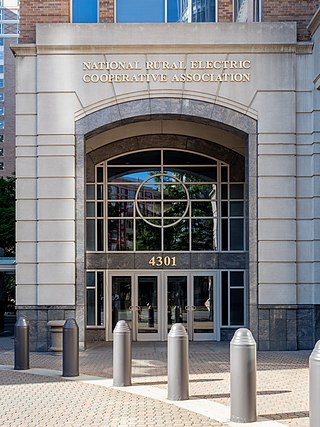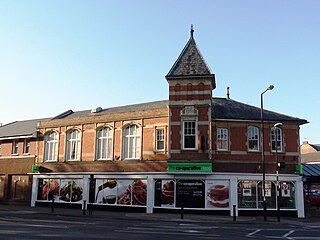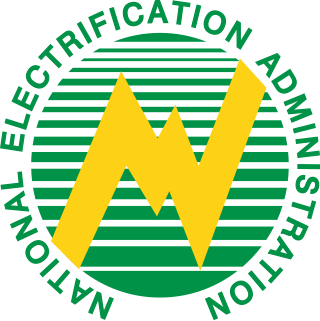
A cooperative is "an autonomous association of persons united voluntarily to meet their common economic, social and cultural needs and aspirations through a jointly owned and democratically-controlled enterprise". Cooperatives are democratically controlled by their members, with each member having one vote in electing the board of directors. Cooperatives may include:

Dothan( DOH-thən) is a city in and the county seat of Houston County in the U.S. state of Alabama. A slight portion of the city extends into Dale and Henry counties. It had a population of 71,072 at the 2020 census, making it Alabama's eighth-largest city by population and the 5th largest in Alabama by total area. It is near the state's southeastern corner, about 20 miles (32 km) west of Georgia and 16 miles (26 km) north of Florida. It is named after the biblical city where Joseph's brothers threw him into a cistern and sold him into slavery in Egypt.
The United States Rural Utilities Service (RUS) administers programs that provide infrastructure or infrastructure improvements to rural communities. These include water and waste treatment, electric power, and telecommunications services. It is an operating unit of the USDA Rural Development agency of the United States Department of Agriculture (USDA). It was created in 1935 as the Rural Electrification Administration (REA), a New Deal agency promoting rural electrification.
A utility cooperative is a type of cooperative that is tasked with the delivery of a public utility such as electricity, water or telecommunications to its members. Profits are either reinvested for infrastructure or distributed to members in the form of "patronage" or "capital credits", which are dividends paid on a member's investment in the cooperative.
Touchstone Energy Cooperatives is a cooperative federation composed of more than 750 local, consumer-owned utility cooperatives in 46 states in the United States. Touchstone Energy co-ops serve more than 30 million members.

The National Rural Electric Cooperative Association (NRECA) represents the interests of over 900 electric cooperatives in the United States. Cooperatives are not-for-profit and are owned by their membership. Founded in 1942, NRECA unites the country's generation, transmission, and distribution cooperatives found in 47 states, serving over 40 million people. It is headquartered in Arlington, Virginia, and its CEO is Jim Matheson.

The Wiregrass Central Railroad is a shortline railroad operating 19.5 miles (31.4 km) of track from a CSX Transportation connection at Waterford, near Newton, to Enterprise, Alabama via the south side of Fort Novosel. The company was initially a subsidiary of Gulf and Ohio Railways and began operations in 1987 following the purchase of the Enterprise Subdivision branch line of CSX Transportation.
WDHN is a television station in Dothan, Alabama, United States, affiliated with ABC and owned by Nexstar Media Group. The station's studios and transmitter are located on AL 52 in Webb.

A consumers' co-operative is an enterprise owned by consumers and managed democratically and that aims at fulfilling the needs and aspirations of its members. Such co-operatives operate within the market system, independently of the state, as a form of mutual aid, oriented toward service rather than pecuniary profit. Many cooperatives, however, do have a degree of profit orientation. Just like other corporations, some cooperatives issue dividends to owners based on a share of total net profit or earnings ; or based on a percentage of the total amount of purchases made by the owner. Regardless of whether they issue a dividend or not, most consumers’ cooperatives will offer owners discounts and preferential access to goods and services.
A food cooperative or food co-op is a food distribution outlet organized as a cooperative, rather than a private or public company. Food cooperatives are usually consumer cooperatives, where the decisions regarding the production and distribution of its food are chosen by its members. Like all cooperatives, food cooperatives are often based on the 7 Rochdale Principles, and they typically offer natural foods. Decisions about how to run a cooperative are not made by outside shareholders, therefore cooperatives often exhibit a higher degree of social responsibility than their corporate analogues.
The history of the cooperative movement concerns the origins and history of cooperatives across the world. Although cooperative arrangements, such as mutual insurance, and principles of cooperation existed long before, the cooperative movement began with the application of cooperative principles to business organization.

PCC Community Markets is a food cooperative based in Seattle, Washington. With over 58,000 members, it is the largest consumer-owned food cooperative in the United States. Both members and non-members may shop at the retail locations, but members receive certain discounts. The organization currently operates fifteen retail locations. Eight of the fifteen stores are located in Seattle. The West Seattle location reopened on October 2, 2019. The other seven are located in Issaquah, Kirkland, Burien, Bothell, Redmond, Edmonds and Bellevue.
Troy Cablevision is a regional cable television, cable internet, Security Systems, and Voice over Internet Protocol (VoIP) provider that serves Southeast Alabama. Their motto is "Your Hometown Communications Company". It is currently the only cable TV provider in the country that carries Pursuit Channel 24 hours a day. The range of their services include Cable Television, Digital telephone, Broadband as well as Security Systems. Their employees are based in Alabama, from network engineers to receptionists – all the way to the CEO.
West Florida Electric Cooperative, Inc. (WFEC) is a not-for-profit rural electric utility cooperative headquartered in Graceville, Florida. It is a member of the Florida Electric Cooperatives Association, the National Rural Electric Association, PowerSouth Energy Cooperative and the Touchstone Energy Cooperatives alliance.
The National Rural Utilities Cooperative Finance Corporation (CFC) is a member-owned nonprofit cooperative that provides financial products to America's rural electric cooperative network. CFC was established in 1969 to raise funds from the capital markets to supplement the loan programs for electric cooperatives offered by the U.S. Department of Agriculture’s (USDA) Rural Utilities Service (RUS), previously Rural Electrification Administration (REA).

The Oberlin Student Cooperative Association (OSCA) is a non-profit corporation founded in 1962 that feeds and houses Oberlin College students. Located in the town of Oberlin, Ohio, it is independent from but closely tied to Oberlin College. OSCA is one of the largest student housing cooperatives in North America, though membership has declined in recent years.

Solar power in Alabama on rooftops could theoretically provide 29.8% of all electricity used in Alabama, with 20,400 MW of solar panels potentially installed on rooftops.

The National Electrification Administration is a government-owned and controlled corporation (GOCC) attached to the Department of Energy of the Philippines tasked in the full implementation of the rural electrification program (REP) and reinforce the technical capability and financial viability of the 121 rural electric cooperatives (ECs).









